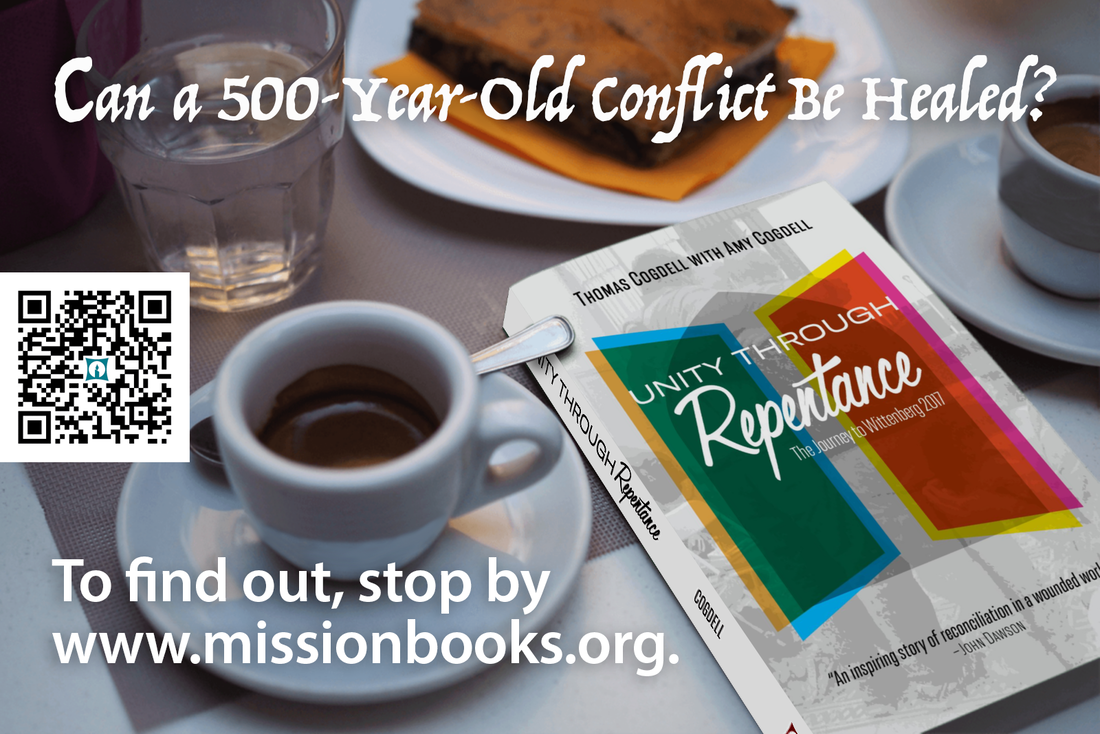Thomas' Story
By Thomas Cogdell
Around the year 2000, my wonderful wife Amy was drawn unexpectedly into the Catholic Church. I remained Protestant, and together we share both worlds. As instructed by her priest, she comes with me each Sunday to Hope Chapel, a Protestant non-denominational church. Frequently I bundle up the kids and attend mass with her.
People who meet us did not immediately realize, “She is Catholic, but he is Protestant.” Instead, they just see a married couple, Amy and Thomas, whom the Lord had mystically made one flesh through the sacrament of marriage.
We have the understanding that this represents, in a very faint way, the radiant beauty of the Church universal – we, the body of Christ, are one body, because He, our Lord, is one God. He has made us one, in a mystical sense.
And yet, for Amy and I this oneness has to be worked out in real, practical moments. I have to apologize for my insensitivity to her. She has to sacrifice her desire for solitude to join me at a prayer meeting. We have to sit down together, listen to each other, and decide together how to structure our life. And so on …
In the same way, mystical oneness in the body of Christ must be worked out in a myriad of practical decisions. Does the Catholic bishop reach out to connect to Protestant pastors in his diocese? Does the “united” prayer gathering of mostly evangelical pastors, invite Catholic priests to participate? How does an Anglican respond upon learning that the Roman Catholic church asks her not to receive communion during mass? How does a Messianic Jew respond when he overhears an Eastern Orthodox believer making statements he considers to reflect replacement theology? And so on …
Jesus set a high bar when He prayed for us, you and me, as recorded in John 17:
My prayer is not for them alone.
I pray also for those who will believe in me through their message,
that all of them may be one, Father, just as you are in me and I am in you.
To me, these words contain an echo of Genesis 2, “a man shall leave his father and his mother, and be joined to his wife; and they shall become one flesh.” It is widely recognized that there is a required “leaving” required for the unity of marriage – a death to previous identity and known way of life. For us to enter, as Jesus prayed, into the unity of the Trinity, must we not also leave behind those aspects of our church identities that are obstacles to reconciliation?
People who meet us did not immediately realize, “She is Catholic, but he is Protestant.” Instead, they just see a married couple, Amy and Thomas, whom the Lord had mystically made one flesh through the sacrament of marriage.
We have the understanding that this represents, in a very faint way, the radiant beauty of the Church universal – we, the body of Christ, are one body, because He, our Lord, is one God. He has made us one, in a mystical sense.
And yet, for Amy and I this oneness has to be worked out in real, practical moments. I have to apologize for my insensitivity to her. She has to sacrifice her desire for solitude to join me at a prayer meeting. We have to sit down together, listen to each other, and decide together how to structure our life. And so on …
In the same way, mystical oneness in the body of Christ must be worked out in a myriad of practical decisions. Does the Catholic bishop reach out to connect to Protestant pastors in his diocese? Does the “united” prayer gathering of mostly evangelical pastors, invite Catholic priests to participate? How does an Anglican respond upon learning that the Roman Catholic church asks her not to receive communion during mass? How does a Messianic Jew respond when he overhears an Eastern Orthodox believer making statements he considers to reflect replacement theology? And so on …
Jesus set a high bar when He prayed for us, you and me, as recorded in John 17:
My prayer is not for them alone.
I pray also for those who will believe in me through their message,
that all of them may be one, Father, just as you are in me and I am in you.
To me, these words contain an echo of Genesis 2, “a man shall leave his father and his mother, and be joined to his wife; and they shall become one flesh.” It is widely recognized that there is a required “leaving” required for the unity of marriage – a death to previous identity and known way of life. For us to enter, as Jesus prayed, into the unity of the Trinity, must we not also leave behind those aspects of our church identities that are obstacles to reconciliation?
Do you know couples who are mixed Catholic / Protestant marriage? What is their life together like?
Where do you take refuge in your church identity, such that you are either (a) hostile to, or (b) insulated from other traditions in the body of Christ?
What is one practical step you can take this week towards unity in the body of Christ?
Where do you take refuge in your church identity, such that you are either (a) hostile to, or (b) insulated from other traditions in the body of Christ?
What is one practical step you can take this week towards unity in the body of Christ?



